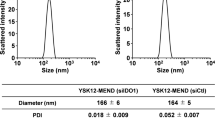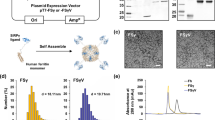Abstract
Antigen-presenting cells such as dendritic cells (DCs) play a critical role in inducing and regulating immune responses. One effective strategy for DC-based immunotherapy is to regulate maturation and function of DC. In this study, we apply single-walled carbon nanotubes (SWNTs) to carry small interfering RNA (siRNA) to reach, enter and genetically modify DCs in vivo. We prepared positively charged SWNTs (SWNTs+) using 1,6-diaminohexane which was demonstrated by transmission electron microscopy equipped with energy-dispersive X-ray spectroscopy and atomic force microscope. The functionalized SWNTs+ could absorb siRNA to form complexes of siRNA with SWNTs. These siRNA:SWNT+ complexes were preferentially taken up by splenic CD11c+ DCs, CD11b+ cells and also Gr-1+CD11b+ cells comprising DCs, macrophages and other myeloid cells to silence the targeting gene. Suppressor of cytokine signaling 1 (SOCS1) restricts the ability of DCs to break self-tolerance and induce antitumor immunity. Infusion of SWNTs+ carrying SOCS1siRNA reduced SOCS1 expression and retarded the growth of established B16 tumor in mice, indicating the possibility of in vivo immunotherapeutics using SWNTs-based siRNA transfer system.
This is a preview of subscription content, access via your institution
Access options
Subscribe to this journal
Receive 12 print issues and online access
$259.00 per year
only $21.58 per issue
Buy this article
- Purchase on Springer Link
- Instant access to full article PDF
Prices may be subject to local taxes which are calculated during checkout






Similar content being viewed by others
References
Sontheimer EJ . Assembly and function of RNA silencing complexes. Nat Rev Mol Cell Biol 2005; 6: 127–138.
Agrawal S, Kandimalla ER . Role of Toll-like receptors in antisense and siRNA. Nat Biotechnol 2004; 22: 1533–1537.
Paroo Z, Corey DR . Challenges for RNAi in vivo. Trends Biotechnol 2004; 22: 390–394.
Manoharan M . RNA interference and chemically modified small interfering RNAs. Curr Opin Chem Biol 2004; 8: 570–579.
Huang WJ, Tayor S, Fu KF, Lin Y, Zhang DH, Hanks TW et al. Attaching proteins to carbon nanotubes via diimide-activated amidation. Nano Lett 2002; 2: 311–314.
Pantarotto D, Briand J, Prato M, Bianco A . Translocation of bioactive peptides across cell membranes by carbon nanotubes. Chem Commun 2004; 1: 16–17.
Williams KA, Veenhuizen PT, De la Torre BG, Eritja R, Dekker C . Nanotechnology: carbon nanotubes with DNA recognition. Nature 2002; 420: 761.
Nguyen C, Delzeit L, Cassell AM, Li J, Han J, Meyyappan M . Preparation of nucleic acid functionalized carbon nanotube Arrays. Nano Lett 2002; 2: 1079–1081.
Pompeo F, Resasco D . Water solubilization of single-walled carbon nanotubes by functionalization with glucosarnine. Nano Lett 2002; 2: 369–373.
Sano M, Kamino A, Okamura J, Shinkai S . Self-organization of PEO-graft-single-walled carbon nanotubes in solutions and Langmuir-Blodgett films. Langmuir 2001; 17: 5125–5128.
Kam NW, Liu Z, Dai H . Functionalization of carbon nanotubes via cleavable disulfide bonds for efficient intracellular delivery of siRNA and potent gene silencing. J Am Chem Soc 2005; 127: 12492–12493.
Shortman K, Liu YJ . Mouse and human dendritic cell subtypes. Nat Rev Immunol 2002; 2: 151–161.
Akbari O, Umetsu DT . Role of regulatory dendritic cells in allergy and asthma. Curr Allergy Asthma Rep 2005; 5: 56–61.
Kubo M, Hanada T, Yoshimura A . Suppressors of cytokine signaling and immunity. Nat Immunol 2003; 4: 1169–1176.
Shen L, Evel-Kabler K, Strube R, Chen SY . Silencing of SOCS1 enhances antigen presentation by dendritic cells and antigen-specific anti-tumor immunity. Nat Biotechnol 2004; 22: 1546–1553.
Singh R, Pantarotto D, McCarthy D, Chaloin O, Hoebeke J, Partidos CD et al. Binding and condensation of plasmid DNA onto functionalized carbon nanotubes: toward the construction of nanotube-based gene delivery vectors. J Am Chem Soc 2005; 127: 4388–4396.
Yang R, Murillo FM, Lin KY, Yutzy WHth, Uematsu S, Takeda K et al. Human papillomavirus type-16 virus-like particles activate complementary defense responses in key dendritic cell subpopulations. J Immunol 2004; 173: 2624–2631.
Hill JA, Ichim TE, Kusznieruk KP, Li M, Huang X, Yan X et al. Immune modulation by silencing IL-12 production in dendritic cells using small interfering RNA. J Immunol 2003; 171: 691–696.
Au WY, Hung KN, Wan TS, Ma E . Side effects related to cancer treatment: CASE 3. Primary cerebral lymphoma after radiotherapy for recurrent meningioma. J Clin Oncol 2005; 23: 8535–8536.
Serafini P, Borrello I, Bronte V . Myeloid suppressor cells in cancer: recruitment, phenotype, properties, and mechanisms of immune suppression. Semin Cancer Biol 2006; 16: 53–65.
Thomas CE, Ehrhardt A, Kay MA . Progress and problems with the use of viral vectors for gene therapy. Nat Rev Genet 2003; 4: 346–358.
Sioud M . On the delivery of small interfering RNAs into mammalian cells. Expert Opin Drug Deliv 2005; 4: 639–651.
Kobayashi T, Yoshimura A . Keeping DCs awake by putting SOCS1 to sleep. Trends Immunol 2005; 26: 177–179.
Peng S, Kim TW, Lee JH, Yang M, He L, Hung CF et al. Vaccination with dendritic cells transfected with BAK and BAX siRNA enhances antigen-specific immune responses by prolonging dendritic cell life. Hum Gene Ther 2005; 16: 584–593.
Lv X, Du F, Ma YF, Wu Q, Chen YS . Synthesis of high quality single-walled carbon nanotubes at large scale by electric arc using metal compounds. Carbon 2005; 43: 2020–2022.
Hazani M, Naaman R, Hennrich F, Kappes M . Confocal fluorescence imaging of DNA-functionalized carbon nanotubes. Nano Lett 2003; 3: 153–155.
Far S, Kossanyi A, Verchere-Beaur C, Gresh N, Taillandier E, Perree-Fauvet M . Bis- and tris-DNA intercalating porphyrins designed to target the major groove: synthesis of acridylbis-arginyl-porphyrins, molecular modelling of their DNA complexes, and experimental tests. Eur J Org Chem 2004; 8: 1781–1797.
Chen J, Hamon MA, Hu H, Chen Y, Rao AM, Eklund PC . Solution properties of single-walled carbon nanotubes. Science 1998; 282: 95–98.
Han G, Tamaki M, Hruby VJ . Fast, efficient and selective deprotection of the tert-butoxycarbonyl (Boc) group using HCl/dioxane (4 m). J Pept Res 2001; 58: 338–341.
Gabrilovich DI, Velders MP, Sotomayor EM, Kast WM . Mechanism of immune dysfunction in cancer mediated by immature Gr-1+ myeloid cells. J Immunol 2001; 166: 5398–5406.
Yang R, Murillo FM, Cui H, Blosser R, Uematsu S, Takeda K et al. Papillomavirus-like particles stimulate murine bone marrow-derived dendritic cells to produce alpha interferon and Th1 immune responses via MyD88. J Virol 2004; 78: 11152–11160.
Acknowledgements
This work was supported by the ‘863’ project (Grant no. 2003AA302640) of the Ministry of Science and Technology of China, Postdocorate Funding (Grant no. 20040055020) of the Ministry of Education of China, NSF Funding (Grant no. 043803711) of Tianjin City, NSFC Funding (Grant no. 30540022) and Nankai University Funding.
Author information
Authors and Affiliations
Corresponding authors
Rights and permissions
About this article
Cite this article
Yang, R., Yang, X., Zhang, Z. et al. Single-walled carbon nanotubes-mediated in vivo and in vitro delivery of siRNA into antigen-presenting cells. Gene Ther 13, 1714–1723 (2006). https://doi.org/10.1038/sj.gt.3302808
Received:
Revised:
Accepted:
Published:
Issue Date:
DOI: https://doi.org/10.1038/sj.gt.3302808
Keywords
This article is cited by
-
Length effects on the dynamic process of cellular uptake and exocytosis of single-walled carbon nanotubes in murine macrophage cells
Scientific Reports (2017)
-
Impact of carbon nanotubes and graphene on immune cells
Journal of Translational Medicine (2014)
-
Carbon nanotubes: properties, synthesis, purification, and medical applications
Nanoscale Research Letters (2014)
-
Investigation of a QM/MM study on interaction of a carbon nanotube with cytarabine drug in various solvents and temperatures
Journal of Nanostructure in Chemistry (2013)
-
The application of carbon nanotubes in target drug delivery systems for cancer therapies
Nanoscale Research Letters (2011)



